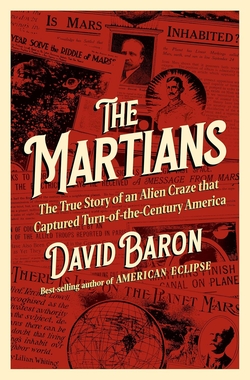Centauri Dreams
Imagining and Planning Interstellar Exploration
Tightening Proxima Centauri’s Orbit (and an Intriguing Speculation)
Although I think most astronomers have assumed Proxima Centauri was bound to the central binary at Alpha Centauri, the case wasn’t definitively made until fairly recently. Here we turn to Pierre Kervella (Observatoire de Paris), Frédéric Thévenin (Côte d’Azur Observatory) and Christophe Lovis (Observatoire Astronomique de l’Université de Genève). We last saw Dr. Kervella with reference to a paper on aerographite as a sail material, but his work has appeared frequently in these pages, analyzing mission trajectories and studying the Alpha Centauri system. Here he and his colleagues use HARPS spectrographic data to demonstrate that we have at Centauri a single gravitationally bound triple system. This is important stuff; let me quote the paper on this work to explain why (italics mine):
Although statistical considerations are usually invoked to justify that Proxima is probably in a bound state, solid proof from dynamical arguments using astrometric and radial velocity (RV) measurements have never been obtained at a sufficient statistical significance level. As discussed by Worth & Sigurdsson (2016), if Proxima is indeed bound, its presence may have impacted planet formation around the main binary system.

This is a six-year old paper, but I want to return to it now because a new paper from the same team will tighten up its conclusions and slightly alter some of them. We’ve gone from resolving whether Proxima is bound to the A/B binary to pondering the issues involved in the dynamical history of this complex system. That in turn can inform the ongoing search for planets around Centauri A and B at least in terms of explaining what we might find there and how these two systems evolved. The original paper on this work lays out the challenges involved in tracing the orbit of the red dwarf. For HARPS is exquisitely sensitive to the Doppler shifts of starlight, and these data, obtained between 2004 and 2016, contain potential booby traps for analysis.
Image: Pierre Kervella, of the Observatoire de Paris/PSL.
Convective blueshift is one of these. We’re looking at the star’s spectral lines as we calculate its motion, and some of these are displaced toward the blue end of the spectrum because of the structure of its surface convection patterns. The lifting and sinking of hot internal gases has to be factored into the analysis and its effect nulled out. The spectral lines are displaced toward the blue, in effect a negative radial velocity shift, although the effect is stronger for hotter stars. In the case of Proxima, Kervella’s team finds a relatively small convective blueshift, though still one to be accounted for.
A similar though more significant issue is gravitational redshift, which occurs as photons climb out of the star’s gravity well. Here the effect is “an important source of uncertainty on the RV of Proxima” whose value can be established and corrected. How the astronomers went about making these corrections is laid out in a discussion of radial velocities that aspiring exoplanet hunters will want to read.
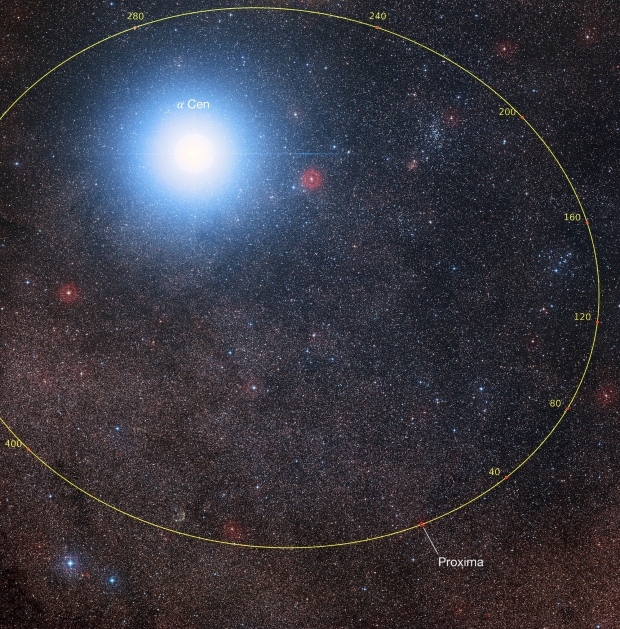
Image: Orbital plot of Proxima showing its position with respect to Alpha Centauri over the coming millenia (graduations in thousands of years). The large number of background stars is due to the fact that Proxima is located very close to the plane of the Milky Way. Credit: P. Kervella/ESO/Digitized Sky Survey 2/Davide De Martin/Mahdi Zamani.
Out of all this we learn that Proxima’s elliptical orbit around Centauri A and B’s barycenter extends from 800 billion kilometers when closest (periastron) to 1.9 trillion kilometers at apastron, its farthest distance, with an orbital period of approximately 550,000 years. The orbital phase is currently closest to apastron.
The Astronomy & Astrophysics site (this is the journal in which the paper above appeared) is currently down, so I’m quoting from the version of the paper on arXiv, which after noting that the escape velocity of Alpha Centauri at Proxima’s distance (545 +/- 11 m/s) is about twice as large as Proxima’s measured velocity, goes on to speculate in an intriguing way:
Proxima could have played a role in the formation and evolution of its planet (Anglada-Escudé et al. 2016). Conversely, it may also have influenced circumbinary planet formation around αCen (Worth & Sigurdsson 2016). A speculative scenario is that Proxima b formed as a distant circumbinary planet of the αCen pair, and was subsequently captured by Proxima. Proxima b could then be an ocean planet resulting from the meltdown of an icy body (Brugger et al. 2016). This would also mean that Proxima b may not have been located in the habitable zone (Ribas et al. 2016) for as long as the age of the αCen system (5 to 7 Ga; Miglio & Montalbán 2005; Eggenberger et al. 2004; Kervella et al. 2003; Thévenin et al. 2002).
The idea of Proxima b as a captured planet has not to my knowledge appeared anywhere else in the literature. I was fascinated, enough so that I dashed off a quick email to Dr. Kervella asking about this as well as the current status of the orbital calculations. And indeed, his response indicates new work in progress:
… we identified a mistake in our 2017 determination of the orbital parameters of Proxima. In the papier, they are expressed in the Galactic coordinate system, and the orbital inclination is thus not directly comparable to that of the Alpha Cen AB orbit. We are preparing a new publication with revised orbits and parameters for all three stars. The main difference is that now the orbital plane of Proxima is better aligned with that of AB. The gravitationally bound nature of Proxima with Alpha Cen AB is also strengthened, as we include new astrometry and radial velocities.
I’ll cover the new paper as soon as it appears. Dr. Kervella also observes that confirming a scenario of Proxima b as a captured planet would be difficult (Proxima b has ‘forgotten’ the history of its orbital evolution, as he puts it), meaning that working with astrometric data alone will not be sufficient. But the arrival of telescopes like the Extremely Large Telescope, now under construction in Chile’s Atacama Desert with first light planned for 2028, should signal a treasure trove of new information. A spectrum obtained by ELT could show us whether Proxima b is indeed an ocean planet.
The paper on Proxima Centauri’s orbit is Kervella, Thévenin & Lovis, “Proxima’s orbit around α Centauri,” Astronomy & Astrophysics Vol. 598 (February 2017), L7 (abstract/preprint).

The Odds on Alpha Centauri
How extraordinary that the nearest star to Earth is actually a triple system, the tight central binary visually merged as one bright object, the third star lost in the background field but still a relatively close 13000 or so AU from the others. Humans couldn’t have a better inducement to achieve interstellar flight on the grounds of these stars alone. We get three stellar types: The G-class Centauri A, the K-class Centauri B, both of which are capable of hosting planets, perhaps habitable, of their own.
And then we have Proxima Centauri, opening up M-class red dwarf stars to close investigation, and we already know of a planet in the habitable zone there, adding to the zest of the venture. If extraterrestrial beings in a system like this would have even more inducement to travel, with another star’s planets perhaps as close to them as our own system’s worlds are to us, we humans are also spurred to undertake a journey, because 4.2 light years is a mere stone’s throw in the overall galactic distribution.
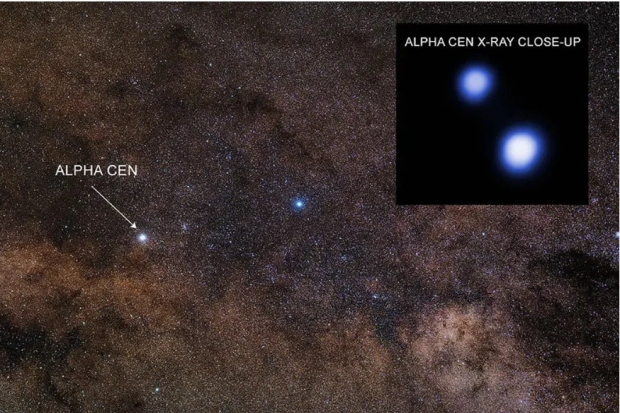
Image: The central binary at Alpha Centauri, with the two stars only resolved in the x-ray image. Credit: X-ray: NASA/CXC/University of Colorado/T.Ayres; Optical: Zdenek Bardon/ESO.
I like this image, used by Dirk Schulze-Makuch to illustrate a recent popular science article, because it includes the Chandra X-Ray imagery. That’s how we can separate the central stars, which are at times nearly as close as Saturn is to the Sun while they orbit their common barycenter. Centauri Dreams readers will recognize Schulze-Makuch (Technical University Berlin and an adjunct professor at Washington State) not only as a prolific writer but the author of a host of scientific papers including many we’ve looked at in these pages. He’s played a valuable role in presenting astrobiological matters to the general public, part of the flowering of interstellar investigation that continues as we keep finding interesting worlds to explore.
If you’re wondering about Proxima Centauri’s location, the image below flags it. Credit: ESO/B. Tafreshi (twanight.org)/Digitized Sky Survey 2; Acknowledgement: Davide De Martin/Mahdi Zamani).
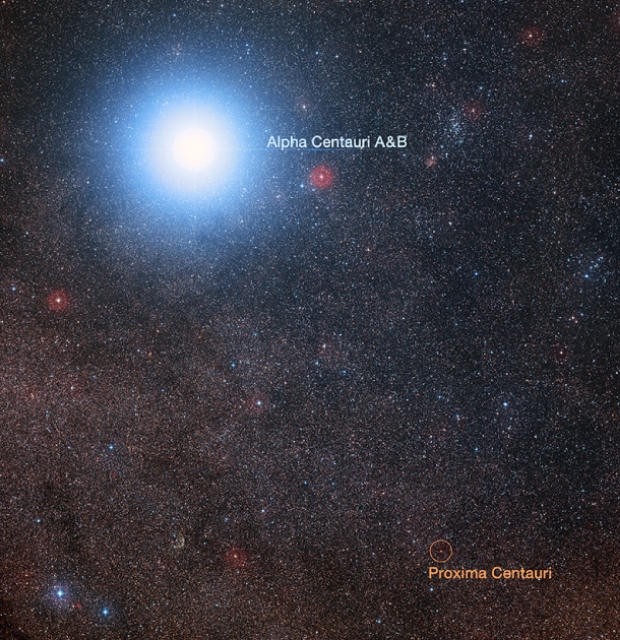
I like to keep an eye on what appears in the popular press from respected scientists, because they’re bringing credibility to matters that often get distorted by mainstream media attention (not to mention what happens on social media sites). We should always give a nod to scientists willing to explain their work and the broader issues involved given that kind of competition for the public’s attention. It’s interesting in this case to get Schulze-Makuch’s take on habitability at Alpha Centauri. He’s pessimistic about Proxima but is surprisingly bullish on Centauri A and B:
The other two stars in the system are believed to have planets, although they have not been confirmed. (A possible Neptune-size planet was reported in 2021 orbiting Alpha Centauri A at roughly the same distance as Earth orbits the Sun, but this could turn out to be a dust cloud instead.) The apparent lack of any brown dwarfs or gas giants close to Alpha Centauri A and B make the likelihood of terrestrial planets greater than it would be otherwise, at least in theory. The chances of a rocky, potentially habitable planet in our neighboring solar system might therefore be as high as 75 percent.
The Proxima Centauri problem is, of course, the X-ray flux, although Schulze-Makuch also considers tidal lock a distinct negative. The Chandra data (citation below) revealed a relatively benign influx of X-rays for Centauri A and B, making them fine hosts for life if it can develop there. But Proxima is deeply problematic, receiving an average dose of X-rays some 500 times greater than Earth’s, and some 50,000 times as great during periods of flare activity, which M-dwarfs are particularly prone to in their younger days.
Here the word ‘younger’ is a bit deceptive. Recall that this kind of star can live for several trillion years. That’s a bit humbling, considering that the universe itself is thought to be 13.8 billion years old. In that sense all M-dwarfs are ‘young.’
Just as we can zoom in via X-ray to see the central stars, we can also take a look at Proxima Centauri’s movements via spectroscopic data, which we’ll examine next time, along with a fascinating speculation on the origin of Proxima b.
For more on the X-ray environment at Alpha Centauri, see Ayres, “Alpha Centauri Beyond the Crossroads,” Research Notes of the AAS Vol. 2, No. 1 (January, 2018), 17 (abstract). The possibility of a ‘warm Neptune’ at Alpha Centauri is discussed in Wagner et al., “Imaging low-mass planets within the habitable zone of α Centauri,” Nature Communications 12, Article number: 922 (2021). Full text. We’ll be talking about this one a bit more in coming days.

Is Interstellar Flight Inevitable?
The wish that humans will one day walk on exoplanets is a natural one. After all, the history of exploration is our model. We look at the gradual spread of humanity, its treks and voyages of discovery, and seamlessly apply the model to a future spacefaring civilization. Science fiction has historically made the assumption through countless tales of exploration. This is the Captain Cook model, in which a crew embarks on a journey into unknown regions, finds new lands and cultures, and returns with samples to stock museums and tales of valor and curiosity.
Captain Cook didn’t have a generation ship, but HMS Endeavour was capable of voyages lasting years, stocking itself along the way and often within reach of useful ports of call. A scant 250 years later, however, we need to consider evolutionary trends and ask ourselves whether our ‘anthropocene’ era will itself be short-lived. Even as we ask whether human biology is up for voyages of interstellar magnitude, we should also question what happens when evolution is applied to the artificial intelligence growing in our labs. This is Martin Rees territory, the UK’s Astronomer Royal having discussed machine intelligence in books like his recent The End of Astronauts (Belknap Press, 2022) and in a continuing campaign of articles and talks.
I won’t comment further on The End of Astronauts because I haven’t read it yet, but its subtitle – Why Robots Are the Future of Exploration – makes clear where Rees and co-author Donald Goldsmith are heading. The title is a haunting one, reminding me of J.G. Ballard’s story “The Dead Astronaut,” a tale in which the Florida launch facilities that propelled the astronaut skyward are now overgrown and abandoned, and the astronaut’s widow awaits the automated return of her long-dead husband. It was an almost surreal experience to read this in the Apollo-infused world of 1971, when it first ran:
Cape Kennedy has gone now, its gantries rising from the deserted dunes. Sand has come in across the Banana River, filling the creeks and turning the old space complex into a wilderness of swamps and broken concrete. In the summer, hunters build their blinds in the wrecked staff cars; but by early November, when Judith and I arrived, the entire area was abandoned. Beyond Cocoa Beach, where I stopped the car, the ruined motels were half hidden in the sawgrass. The launching towers rose into the evening air like the rusting ciphers of some forgotten algebra of the sky.
“[T]he rusting ciphers of some forgotten algebra of the sky.” Can this guy write or what?
You’ll find no spoilers here (Ballard’s The Complete Short Stories is the easiest place to find it these days) but suffice it to say that not everything is as it seems and the scenario plays out in ways that explore human psychology coming to grips with a frontier of deeply uncertain implications. As uncertain, perhaps, as the implications Ballard did not explore here, the growth of artificial intelligence with its own evolutionary path. For that, we can investigate the work of Stanislaw Lem, in particular The Invincible (1964). N. Katherine Hayles wrote a fine foreword to the novel in 2020. Non-human, indeed non-biological evolutionary paths are at the heart of the work.

The scenario should intrigue anyone interested in interstellar exploration. Assume for a moment that a starship carrying both biological beings and what we can call artilects – AI enabled beings, or automata – once landed on a distant planet, where the biological crew died. The surviving artilects cope with the local life forms and evolve gradually toward smaller and smaller beings that operate through swarm intelligence. The driver is the need to function with ever smaller sources of power (the artilects operate via solar power and hence need less as their size decreases), creating an evolutionary pressure that results in intelligent ‘mites.’
A long time later, another crew, the humans of the starship Invincible, has arrived and must cope with the result. As long ago as 1964, before the first Gemini mission had flown, the prescient Lem was saying that swarm intelligence was a viable path, something that later research continues to confirm. As Hayles points out in her foreword, it takes only a few rules to produce complex behaviors in swarming creatures like fish, birds and bees, with each creature essentially in synch with only the few creatures immediately around it. Simple behaviors (in computer terms, only a few lines of code) lead to complex results. Let me quote Hayles on this:
Decades before these ideas became disseminated within the scientific community, Lem intuited that different environmental constraints might lead to radically different evolutionary results in automata compared to biological life forms. Although on Earth the most intelligent species (i.e., humans) has tended to fare the best, their superior intelligence comes with considerable costs: a long period of maturation; a lot of resources invested in each individual; socialization patterns that emphasize pair bonding and community support; and a premium on individual achievement. But these are not cosmic universals, and different planetary histories might result in the triumph of very different kinds of qualities.
In this environment, a visiting starship crew must confront an essential difference in values between the two types of being. Humans bring assumptions drawn out of our experience as a species, including the value of the individual life as opposed to the collective. Remember, we are some years off from Star Trek’s Borg, so once again Lem is pushing the envelope of more conventional science fiction. Hayles will point out that shorn of our anthropocentrism, we may find ourselves encountering forms of artificial life whose behavior can only be traduced by profoundly unsettling experience. A world of collective ‘mites’ may overwhelm all our values.
Given all this, we have to ask whether several more centuries of AI will produce artilects we are comfortable with. The question of control seems almost moot, as what Martin Rees refers to as ‘inorganic intelligence’ quickly moves past our own mental functioning if left to its own devices. We are in the realm of what today’s technologists call ‘strong AI,’ where the artificial intelligence is genuinely alive in its own right, as opposed to being a kind of simulacrum emulating programmed life. A strong AI outcome places us in a unique relationship with our own creations.
The result is a richer and stranger evolutionary path than even Darwin could have dreamed up. We don’t have to limit ourselves to swarms, of course, but I think we can join Rees in saying that creatures evolving out of current AI will probably be well beyond our ability to understand. In a recent essay for BBC Future, Rees quoted Darwin on the entire question of intentionality: “A dog might as well speculate on the mind of [Isaac] Newton.” Not even my smartest and most beloved Border Collie could have done that. At least I don’t think she could, although she frequently surprised me.
A side-note: I would be interested in suggestions for science fiction stories dealing with swarm concepts — as opposed to basic robotics — in the early years of science fiction. Were authors exploring this before Lem?
Rees is always entertaining as well as provocative. He takes an all but Olympian view of the cosmos that draws on his lifetime of scientific speculation, and writes a supple, direct prose that is without self-regard. I’ve only met him once and at that only briefly, but it’s clear that this is just who he is. In a way, what I might consider his detachment from the nonsensical frenzy of too much tenured academic science mirrors deeper changes that could occur as intelligence moves into inanimate matter. Why, for example, keep things like egotism or pomposity (and we all know examples in our various disciplines)? Why keep aggression if your goal is contemplation? For that matter, why live on planets and not between stars?
But for that matter, can we ever know the goal of such beings? As Rees writes:
Pessimistically, they could be what philosophers call “zombies”. It’s unknown whether consciousness is special to the wet, organic brains of humans, apes and dogs. Might it be that electronic intelligences, even if their intellects seem superhuman, lack self-awareness or inner life? If so, they would be alive, but unable to contemplate themselves, or the beauty, wonder and mystery of the Universe. A rather bleak prospect.
For all these what-ifs, I strongly second another Rees statement about first contact: “We will not be able to fathom their motives or intentions.”
As you might guess, Rees is all for pursuing what I always call ‘Dysonian SETI,’ meaning looking for evidence of non-natural phenomena (he includes the study of ‘Oumuamua as possibly technological in the realm of valid investigation). From the standpoint of our interests on Centauri Dreams, we should also consider whether fast-moving AI will not be our best path, at least in the early going, for interstellar exploration of our own. Our biological nature is a tremendous problem for the mechanics of starflight as presently conceived, given travel times of centuries. Until we surmount such issues, I find the prospect of exploration by artilect a rational alternative. What’s intriguing, of course, is whether we can even prevent it.

Eavesdropping on the Neighbors
Given that interstellar communications have been on my mind recently, I was delighted to receive this essay from Don Wilkins. Based in St. Louis, where he is a now-retired aerospace engineer, Don has plenty of experience in avionics and has the chops to know how to make widely-dispersed aircraft talk to each other. Here his scope is a bit wider: What are the implications of ‘lurker’ probes, the conceivably ancient (or newer) technologies from an extraterrestrial civilization that might be monitoring our planet? If such exist, their communications become a SETI target, and the question of how their network might operate is an intriguing one. I had no idea, for example, that the idea of gravitational lensing for such communications had made its way into the SETI field, but Don here acquaints us with several studies that tackle the concept, along with other insights as found below.
by Don Wilkins
If an expansionist star faring civilization exists, it is likely to construct an interstellar communications and control network, beaming information and commands across interstellar depths.[1-7] Information concerning discoveries along with status of developments within a system, to avoid duplication of effort, as an example, are transmitted at high data rates using a star’s gravitational field as a focusing element. Such concepts are familiar to readers of Centauri Dreams.
Failure to find “von Neumann probes” in the Solar System can be related to a hypothesis and a fact. The hypothesis posits aliens hide their presence from a developing civilization until the appropriate time to formally contact the younger society – or perhaps the aliens only want to observe, rather than interact with primitives.
A von Neumann probe is difficult to locate in the vast, uncharted spaces of the Solar System. The Solar System volume is approximately 5 × 1014 cubic astronomical units (AU3) when measured to the outer boundaries of the Oort cloud. Eight planets, hundreds of moons, asteroids, comets and “empty” space provide a multitude of nooks and crannies shy aliens might use to avoid curious neighbors.
An interstellar communications network is characterized by very long delay paths, frequent network partitions needed for delay tolerance and error correction.
The inverse square law mandates a reduction in data rates by three-fourths if the distance between a receiver and transmitter is doubled. If a mesh network links interstellar probes, data rates can be increased orders of magnitude over a communications system relying on direct messaging among the probes.
Consider: The home world of the aliens may be tens of thousands of parsecs distant from a hypothetical node in the Solar System. A mesh of nodes woven through the stars and, located at convenient points in interstellar space, such as nebulae, provide three advantages. Reduced distances between nodes enable faster transmission rates using the same power. A multitude of dispersed nodes provides enhanced reliability through alternate routes to the preferred destination. The mesh network is self-routing avoiding slow, risky centralized communications architectures. These advantages come at the cost of message complexity but are worth the trade-off.
As an aside, if communications relays are located to optimize bandwidth, it may be difficult, if not impossible, for a civilization such as ours to intercept tight beamed transmissions among the probes. Even if a transmission is intercepted, and if the aliens use store and forward architectures and use multiple frequencies to transmit portions of the messages, only combining transmissions at the receiver, it may be impossible for us to identify signals as of intelligent origin or translate them into a coherent message. Transmissions are burdened with metadata, routing information, further complicating understanding of interceptions, Figure 1.
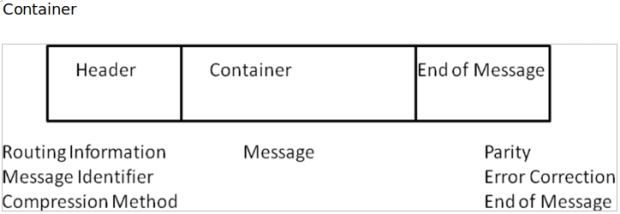
Figure 1 Message Encapsulation for Network Transmission
Given unknown compression techniques, error correction methods, message structure, and splitting messages among different frequencies and routes, intercepting and understanding traffic on the alien network may be impossible.
Frank Drake and others proposed direct communications using simple messages among the stars. “Hello” messages are sequences of bit strings easily reformatted into images depicting the Solar System and humans. If alien probes established interstellar mesh networks, it is highly probable those networks ignore Drake-type messages.
Von Neumann probes could explain the Great Silence. If robots are spreading into every nook and cranny of the Galaxy, the efficiency of radio transmissions as the contact medium is open to doubt. The physical presence of a probe in a distant star system removes any doubts about the nature of the signal. An alien spaceship provides instantaneous interchanges rather than slow century long conversations. Information density as represented by the probe is considerably greater than a radio signal could provide. Aliens may wait for contact through probes rather than relying on energy-hungry beams subject to misunderstanding launched into the unknown.
Researchers hypothesize signals intended for solar gravitational lens receivers could serve as technosignatures of advanced alien civilizations. Figure 2 diagrams a link between a transmitter in orbit about an alien star and a receiver within the Solar System.

Figure 2 Architecture of a communications network based on an Einstein Ring [8].
In addition to detecting stray communications from distant transmitters, other detection methods are possible. A possible technosignature is light reflected from a station-keeping light sail. Assuming the communications node uses a light sail to maintain the system’s position, the sail reflects the Sun’s light back into the Solar System. A “star” whose spectrum suspiciously matches that of the Sun could point to the existence of an alien communications node.
Another technosignature possibility is an area of space which is slightly warmer than expected. This could be a clue that something is trying to hide by spreading its waste heat into a low temperature, innocuous blob.
If an alien probe is located, we could message the robot. “Active ” SETI, where humans transmit to aliens, rather than listen for alien communications, has roused protests from those who worry aliens are hostile. Communicating with alien nodes within the Solar System does not provide aliens with information which they do not already possess and avoids the concerns of active SETI opponents.
Researchers avoid the issue of identifying a signal by content. An alien relay using gravitational lensing is effectively motionless in relation to the Sun. Monochromatic signals should present Doppler shifts resulting from the Earth’s orbit and rotation assuming terrestrial based sensors.
Kerby and Wright generated criteria for a long-duration node using gravitational lensing [8]:
1. Close or moderately-distanced companion stars impart huge delta-v costs on a relay spacecraft, and thus close binary or multiple-star systems should be avoided.
2. The presence of gas giant planets either limits the maximum gain total of the stellar relay (depending on the reflex semimajor axis imparted on the host star) or imparts a delta-v cost of a few m s−1 per year to maintain alignment.
3. A more massive host star requires proportionally higher delta-v costs to resist its inward gravity.
4. A host star that is rapidly rotating will be deformed away from a spherical shape, resulting in a lens that does not have an exact focal point from which to transmit, resulting in significantly lowered gains.
The search for alien communications nodes orbiting nearby stars has already begun,
Table 1. Nearest network node: location priority list (top 10)
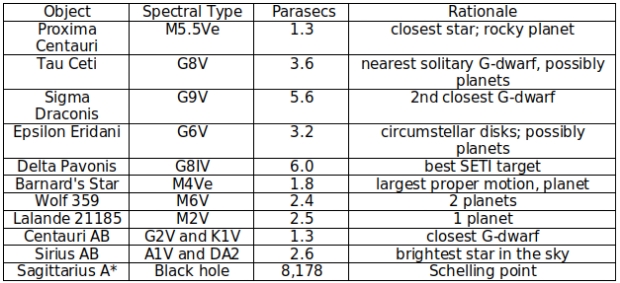
Note: In game theory, a Schelling point is a choice made without communication among the involved parties. Sagittarius A* may be chosen as a communications hub by aliens simply because it is such a visible feature located in the center of the Galaxy.
M. Gillon and other researchers examined Wolf 359 and TRAPPIST–1 for evidence of communications nodes in the vicinity of those stars.[5] No evidence of alien communications nodes was uncovered although there are any number of possible explanations for failure. The search continues and, contingent on funding, will expand to between ten and twenty stars.
For six months, a team led by G.W. Marcy searched for continuous and short period laser emissions from Proxima and Alpha Centuri. [6] Search equipment can detect power levels as low as one hundred Watts. No artificial laser light was observed in frequencies between 380 to 950 nanometers.
From the paper:
The intended recipient of the transmission is located at an unknown location near Proxima Centauri, leaving uncertain the most likely location of the local transmitter. Thus, during a year of observations, a transmitter located near the SGL focus line could appear within a region of roughly 400 arcsec from the coordinates given above. Parallax and aberration can be predicted for any instant, but the unknown location of the receiver near Proxima Centauri leaves the SGL location unknown within roughly 60 arcsec. We search within the full 400 arcsec domain for both sub-second pulses and long-lived emission of monochromatic sources. Our total field of view of 2.2 x 2.2 deg easily includes that 400 arcsec domain. Exploring the relatively large area around the anti-solar position of Proxima Cen expands the survey to include emitters located off-center that target only a fraction of the focal ring surrounding the Sun.
Two telescopes were used in the search. Candidate detections in the first were checked against exposures taken in the second telescope. No correlations were found.
Finally, a team used the Green Bank Telescope (GBT) and Breakthrough Listen (BL) backend to listen in the L and S bands for nodes using the Sun as for gravitational focusing [7]. The search covered possible nodes for Alpha Centauri AB system and HD 13908. This search was also unsuccessful although the work was regarded as proof-of-concept.
Searching for nodes in an interstellar network with a terminus within the Solar System has just begun. Earth based sensors can make relatively low-cost searches for Lurkers. Even if the probability of success is low, the enormous rewards of success merit the investment.
References
1. M. Gillon, A Novel SETI Strategy Targeting the Solar Focal Regions of the Most Nearby Stars, Acta Astronautica 94, 629 (2014)
2. M. Hippke, Interstellar Communications I Network, Overview and Assumptions, arXiv 1912.02616v2 (2019)
3. M. Hippke, Interstellar Communications II Deep Space Nodes with Gravitational Lensing, arXiv 2009.01866v1 (2020)
4. M. Hippke, Interstellar Communications III Locating Deep Space Nodes, arXiv 2104.09564v1 (2020)
5. M. Gillon, A. Burdanov, and J.T. Wright, Search for an Alien Communication from the Solar System to a Neighbor Star, arXiv 2111.05334 (2021)
6. G.W. Marcy, S.K.Tellis, and E.H. Wishnow, Laser Communications with Proxima Centauri using the Solar Gravitational Lens, Monthly Notices of the Royal Astronomical Society, 509-3, 3798-3814, https://arxiv.org/ftp/arxiv/papers/2110/2110.10247.pdf, (2022)
7. Nick Tusay, et al, A Search for Radio Technosignatures at the Solar Gravitational Lens Targeting Alpha Centauri, arXiv 2206.14807v1 (2022)
8. Stephen Kerby and Jason T. Wright, Stellar Gravitational Lens Engineering for Interstellar Communication and Artifact SETI, The American Astronomical Society, 2021 November 19, https://iopscience.iop.org/article/10.3847/1538-3881/ac2820

Mars Agriculture – Knowledge Gaps for Regolith Preparation
Let’s break for a moment with interstellar issues to finish up a story I first covered at the beginning of the year. In 2022, members of the Interstellar Research Group led by Doug Loss began exploring the biological side of establishing a human presence on Mars. By ‘biological,’ what the team was looking at was how to create soil as opposed to regolith, soil with the microbial components needed to produce crops for human consumption on Mars. Alex Tolley wrote the idea up in MaRMIE: The Martian Regolith Microbiome Inoculation Experiment. Today’s post is the finalized document that has grown out of this effort, an attempt to foster further research by offering a framework for experiment. While the IRG lacks the means of executing these experiments itself, it offers this paper as a contribution to planetary studies to connect with those who can.
by Alex Tolley and Doug Loss*
* Contact: Doug Loss at douglas.loss@irg.space
Abstract
The proposed designs for the settlement of Mars include various approaches for local food production. Food will most likely be based on traditional terrestrial crops to ensure that a variety of cuisines can be cooked for the well-being of the settlers. To farm on Mars, as well as provide an environment for plants and trees, will require establishing soils using the Martian regolith. The presence of (per)chlorates at levels toxic to plants and humans requires remediation of the regolith to remove the (per)chlorates. Prior work indicates that there is a knowledge gap in how to remediate the regolith to make it ready to support various crops for Martian agriculture. We propose a framework of experiments to help bridge the gap between the state of the regolith on the surface and the initial stages of soil creation.
Introduction
With the renewed interest in settling Mars, there has been considerable attention on how to feed a base crew and its subsequent expansion into a larger settlement population. Unlike a human presence in low Earth orbit (LEO) and on the Moon where travel times are sufficiently short that food can be provided in regular shipments from Earth, the long 6 to 9-month, low-energy journeys to Mars that have 2-year gaps between flights, suggest that using local Martian resources to grow food would be a better option, both from economic and safety perspectives.
It should be noted that the flight times with current rocket transport technology are similar to that of the sailing ships traveling from England to the Botany Bay colony in Australia in the late 18th century. The resupply ship arrived 2 years later, with the colony starving from inadequate food supplies and an inability to successfully farm. Local food production on Mars would ensure that adequate, high-nutrition foods are available and avoid any supply problems from Earth.
The lower ambient light levels on Mars are sufficient for photosynthesis for a large range of plants from unicellular algae to many terrestrial crops [28]. Additional light if needed can be supplied with mirrors or artificial lighting. The question then becomes what sort of plants should be cultivated? The simplest plants, such as cyanobacteria, have been proposed as they have short lifecycles and rapid growth, requiring small production areas and a few basic nutrients. However, anecdotal evidence from supplying astronauts to the ISS indicates that food quality is a very important factor in astronaut well-being [46,47,48]. Experiments with celebrity chef-developed meals have proven the popularity of meals that are similar to those on Earth and that are tasty, not just nutritious. For crew and settlers staying for long periods on Mars with minimum 2-year rotations, foods that can be prepared with different cuisines to be cooked by a base chef or personally would seem to be preferable. Cyanobacteria and algal species may grow quickly and be technically nutritious. However, algae is not a completely nutritious diet and only Spirulina [30] has been shown to be useful as a meal supplement, used for less than 1% of the diet, and therefore should be considered as feedstuffs for animals and as soil amendments.
Growing conventional food hydroponically [28] is often mooted as the means to grow conventional crops. It has the advantage of having a pedigree of experience in terrestrial farms as well as experimental success in space. Hydroponic food production can be carefully controlled which makes it attractive to those of technical expertise. However, hydroponics requires substantial inputs of nitrogen and phosphorus which are usually applied directly from external sources, and not all plants can be successfully grown hydroponically. In addition, an expansion for a growing settlement will require either transporting equipment from Earth or finding ways to manufacture at least the simple components locally on Mars. A more attractive approach has been to try growing conventional crops in the Martian regolith. Experiments using regolith simulants [4] have shown that given added nutrients and light, a number of common terrestrial leafy crops can be grown.
The advantage of using the Martian regolith as a medium to grow conventional crops is that it provides the needed anchorage and potentially water retention medium used by terrestrial plants. Martian agriculture would work like terrestrial agriculture which is done in a greenhouse. On Mars, the atmosphere and temperature would be controlled to maximize crop growth and it is feasible that some animal species might be transported to produce the high-protein foods. For example, fish eggs could be transported and herbivorous fish species such as Tilapia could feed on the algae and convert it for human consumption. However, it should be noted that soils are not simple, but include ecosystems with a large number of species including bacteria, fungi, and animals from annelid worms to insects..
Despite the research done to date, there are considerable gaps in our knowledge concerning how Martian agriculture should proceed. The Martian environment is very cold, and dry, with a thin atmosphere around 0.1% of Earth’s, composed mainly of carbon dioxide with a little nitrogen. While aqueous algal growth experiments have been done in conditions that approximate some of the Martian conditions, it is not known which conditions must be tightly
controlled for good growth of the algae. For complex plants that are to be grown in either regolith or hydroponically, what partial pressure of CO2 in the atmosphere and at what pressure is needed to ensure healthy growth? Crops grow in different soils on Earth, from near desert sandy soils for millet to rich dark loams and different acidities for different crops. We take for granted the quality of terrestrial soils, but on Mars, the regolith is considered sterile, with no organic carbon content to retain water and provide an environment for soil organisms.
Given that these conditions can be evaluated on Earth, the big gap in our knowledge is the issue of remediation of the toxic levels of (per)chlorates in the Martian regolith. All of the various experiments on growth conditions assume that none of these toxic compounds are present. Powdered terrestrial rocks and more carefully constructed Mars Regolith Simulants are free of (per)chlorates and therefore experiments on plant growth assume the (per)chlorates are removed. With (per)chlorate levels that are far higher than any found naturally on Earth, they are at levels found around sites that manufacture munitions where the compound is used as an oxidant. The US EPA has guidelines for the remediation of soils contaminated by (per)chlorates [36].
Soils can vary, with plants varying in requirements for water, nutrients, soil carbon, soil organisms, pH, climate, and weather conditions. Nutrients and organic carbon will need to be added, as well as soil organism inoculants to improve the regolith to become a soil capable of good crop production.
To get an agricultural food system working, which factors are critical? How best to detoxify the regolith? How best to amend its properties? Which crops are best suited and at which stages?
A low-mass approach is to employ bacteria that can metabolize (per)chlorates and grow locally. (Per)chlorate metabolizing organisms are proteobacteria of which there are more than 40 species known. Dechloromonas and Azospira genera appear to be ubiquitous on Earth. They have different pH tolerances and some can function in acidic conditions as low as pH 5 [10] The Martian regolith has up to 1% of (per)chlorate [13] which is far higher than any uncontaminated place on Earth. (Per)chlorate reduction only occurs in anaerobic conditions [3]. This suggests that regolith remediation may need to be kept isolated from the crop-growing areas. Experiments with Moorella sp show that these bacteria can grow on a variety of reduced carbon sources, optimally at neutral pH and warm temperatures (40-70C) [2]. None of the experiments have tested the (per)chlorate-reducing metabolic rates and growth of the various potential bacterial inoculants under conditions between Mars and human habitation, such as lower atmospheric pressure, gas composition, and water requirements. As these bacteria need a carbon source, how would that source be provided by chemical means or by biological carbon fixation?
There is considerable interest in using cyanobacteria as carbon-fixing microorganisms. These hold promise to weather the regolith, release nitrogen and phosphorus for growth, create organic carbon to improve water retention, and allow a richer variety of solid organisms that may be needed for crop growth. These cyanobacteria have been tested in a variety of conditions to determine how they will fare under conditions closer to that on the surface of Mars. Resting states of cyanobacteria suitable for transport from Earth indicate that UV exposure is not tolerated, although survival in a vacuum is good [34]. Cyanobacteria do require a lot of water to suspend the rock dust and particles, In CO2-dominant atmospheres, full terrestrial pressure reduces growth, partly because of the lowered pH of the aqueous media, while 100 mbar appeared more favorable. Temperatures need to be maintained between 15 and 30C. Most important is the finding that cyanobacteria cannot survive in (per)chlorate-contaminated conditions, requiring its removal before growth [30]. Extensive testing of bacteria has shown that while a few can survive down to the 7 mbar of the Martian atmosphere, most require at least 25 mbar. Nitrogen-fixing bacteria can fix atmospheric nitrogen to as low as 1 mbar, but the 2.8% of nitrogen in the Martian atmosphere would require increasing the total local atmospheric pressure 50x.[40]
From this prior work, it is clear that there is a difficulty in remediating the Martian regolith from its toxic state to a soil suited for crop growth. (Per)chlorate-reducing bacteria require reduced carbon sources with nitrogen and phosphorus for growth to detoxify the regolith. Ideally, this could be supplied by cyanobacteria that fix the CO2 in the atmosphere and can release the nitrogen and phosphorus from the regolith. The cyanobacteria can also provide the organic carbon in the soil to support crop growth. However, these cyanobacteria cannot tolerate the toxic (per)chlorates. Lastly, both the (per)chlorate-reducing bacteria and the cyanobacteria need to grow in aqueous conditions with the regolith particles separated to allow rapid microorganism growth. The regolith would then need to be drained and allowed to dry out before being suited to most crop growth, although rice might be able to grow in a “paddy field” of regolith that has settled. This suggests that there may need to be separate areas for removing the (per)chlorates, supplying needed nutrients for the (per)chlorate-reducing bacteria, by cyanobacteria growing in pre-treated regolith.
The following outline experiments are suggested to fill the gaps in treating the Martian regolith to make it suited for growing crops for the Martian settlement.
Suggested experiments
The exposed Martian regolith is both too cold and dry, as well as relatively airless, for bacteria to detoxify the (per)chlorates. Ideally, the detoxification would take place in optimal growth conditions for the bacteria. Given that maintaining atmospheric composition and pressure, as well as water and humidity conditions, incurs a mass penalty, it is important to determine what are the factors that can be reduced towards Mars’ conditions to reduce this cost. This will help decide whether the detoxification process must be carried out in a greenhouse suited to growing conventional crops, or whether simpler management of the regolith is sufficient. Other questions are also evident, such as the level of detoxification necessary before crops can be successfully grown in the treated regolith.
This suggests several experiments to test for these factors:
1. Composition of Bacterial inoculant
There are many known terrestrial (per)chlorate-metabolizing bacteria, e.g. Dechloromonas that can metabolize oxygenated chlorines. All are anaerobes and therefore may function with the existing composition of the Martian atmosphere. Questions to be considered are:
a. Should the inoculant be a single species or multiple?
b. Do other species need to be included to create a viable ecosystem, or are single-species populations both sufficient and effective?
2. Atmospheric pressure
Mars’s atmosphere is about 0.7% of that of Earth. While too low to support crop plants, how much pressure is needed for bacterial growth to be maintained? Unlike plants, the bacteria are aquatic, and therefore the needed atmospheric pressure need only be sufficient to prevent water from boiling off. In a sealed reactor, water vapor will provide the needed pressure to maintain the equilibrium. As the bacteria are anaerobes, the regolith would seem likely to be processed in separate areas from the crop plants, with the detoxified regolith then added to the agricultural area in the greenhouse to increase the cultivation area.
3. Atmospheric composition
Mars’ atmosphere is primarily CO2 with a little N2. This is not suitable for crop plants, but how much of a factor is this for the bacteria? Combined with atmospheric pressure, what composition is needed for the bacteria? For example, does the nitrogen partial pressure need to be increased to supply the needed nitrogen for bacterial growth, perhaps in combination with nitrogen-fixing bacteria in the inoculant, or just added as ammonia or nitrate? [c.f. Item 1 concerning species in the inoculant.]
4. Hydration
Lastly, bacteria need wet conditions to grow and multiply. How wet does the regolith need to be for the bacteria? Do the bacteria survive and grow in an aqueous slurry, or would high humidity conditions be sufficient, saving water resources needed elsewhere?
To test these, experiments will need to be set up in conditions to test these various requirements, most probably in containers to maintain the conditions. It is assumed that surface UV and ionizing radiation do not need to be tested as simple shielding will be sufficient to mitigate these factors.
These experiments are primarily devoted to extending the existing work done on (per)chlorate removal by bacteria [2,10,13,22], extending prior work. If the regolith detoxification and preparation for traditional crops is to be the goal, the regolith will need additional preparation for crops, including nitrogen, phosphorus, and carbon supplements. Inoculants may be required to allow nitrogen-fixing bacteria to grow in association with the root nodules of crops like green beans. Prior experiments [30,34,40] with cyanobacteria have demonstrated the extraction of nitrogen from the regolith, suggesting this approach to fertilize the crop plants after the regolith has been cleared of the toxic chlorate and (per)chlorate.
A stretch goal might include gene splicing experiments to extend the capabilities of some microbial species. Can the (per)chlorate-reducing genes be added to cyanobacteria removing the need for the bacterial species? Conversely, can genes to extract the nitrogen and phosphorus from the regolith be inserted into the bacteria? Can the (per)chlorate genes be edited so that the oxygen is liberated safely in the organism, allowing the (per)chlorate to become an oxygen source for the Martian settlement? Suggestions as to possible ideas have been mooted [40, 49].
Conclusion
To start processing Martian regolith for food production on Mars, there is a substantial gap in our knowledge on getting this process underway in the volumes needed compared to the small-scale lab experiments. Firstly, the regolith must be detoxified to remove the (per)chlorates. While the lab experiments demonstrate that various species of bacteria can metabolize the (per)chlorates, there are two limitations. Firstly, the regolith needs to be in powdered form to expose the surfaces to the bacteria and be turned into an aqueous environment for the bacteria to survive. How wet the slurry needs to be is unknown and therefore the water requirements are also unknown. Secondly, the sterile regolith provides no useful food supplies for the bacteria to grow. How to supply the nutrients and from what source needs to be determined. Terrestrial starter kits may be inadequate for bulk regolith processing.
Cyanobacteria have been demonstrated in the lab to be able to fix the atmospheric CO2 and grow while extracting the needed nitrogen, phosphorus, and trace elements from the regolith, but only after the (per)chlorates have been removed.
Terrestrial crops are yet another step away as they need detoxified regolith, fertilizers, and organic carbon in the “soil” to grow successfully, suggesting that both the (per)chlorate-metabolizing bacteria and the cyanobacteria must preprocess the regolith.
While the bacterial cultures grow in aqueous conditions, terrestrial crops do not and are therefore subject to even more critical issues of the surrounding atmosphere: pressures, and composition.
Currently, it appears as if the regolith can be prepared by iteratively starting with (per)chlorate-metabolizing bacteria, followed by cyanobacteria to grow and produce the needed food for a larger amount of regolith to be detoxified so that large volumes of regolith can be prepared for conventional crops to be grown. Once the regolith has been prepared it is turned over to the agronomists to determine how best to provide the conditions and associated organisms to cultivate crops to feed the base crew or settlers. While hydroponics is favored for supplying small populations with food, more conventional agriculture using local resources including the regolith seems more likely to be the preferred approach once large settlements start to appear.
References
Atri, Dimitra, et al. “Estimating the Potential of Ionizing Radiation-induced Radiolysis for Microbial Metabolism in Terrestrial Planets With Rarefied Atmospheres.” arXiv (Cornell University), Cornell University, July 2022, https://doi.org/10.48550/arxiv.2207.14675.
Balk, Melike, et al. “(per)Chlorate Reduction by the Thermophilic Bacterium Moorella Perchloratireducens Sp. Nov., Isolated From Underground Gas Storage.” Applied and Environmental Microbiology, vol. 74, no. 2, American Society for Microbiology, Jan. 2008, pp. 403–09. https://doi.org/10.1128/aem.01743-07.
Bender, Kelly S., et al. “Identification, Characterization, and Classification of Genes Encoding Perchlorate Reductase.” Journal of Bacteriology, vol. 187, no. 15, American Society for Microbiology, Aug. 2005, pp. 5090–96. https://doi.org/10.1128/jb.187.15.5090-5096.2005.
Bennett, Jaemie. “The Experimentation of Growing Plants on Mars.” www.jhunewsletter.com, 2018, www.jhunewsletter.com/article/2018/10/the-experimentation-of-growing-plants-on-mars. Accessed 6 Aug. 2023.
Calderón, R., et al. “Perchlorate Levels in Soil and Waters From the Atacama Desert.” Archives of Environmental Contamination and Toxicology, vol. 66, no. 2, Springer Science+Business Media, Oct. 2013, pp. 155–61. https://doi.org/10.1007/s00244-013-9960-y.
Cannon, K. M., et al. “Mars Global Simulant MGS-1: A Rocknest-based Open Standard for Basaltic Martian Regolith Simulants.” Icarus, 1 Jan. 2019, doi.org/10.1016/j.icarus.2018.08.019.
Cartier, Kimberly. “Tests Indicate Which Edible Plants Could Thrive on Mars.” eos.org, 2018, eos.org/articles/tests-indicate-which-edible-plants-could-thrive-on-mars. Accessed 6 Aug. 2023.
Cartier, Kimberly M. S., and Kimberly M. S. Cartier. “Tests Indicate Which Edible Plants Could Thrive on Mars.” Eos, Jan. 2022, eos.org/articles/tests-indicate-which-edible-plants-could-thrive-on-mars.
—. “Tests Indicate Which Edible Plants Could Thrive on Mars.” Eos, Jan. 2022, eos.org/articles/tests-indicate-which-edible-plants-could-thrive-on-mars.
Coates, John D., and Laurie A. Achenbach. “Microbial Perchlorate Reduction: Rocket-fuelled Metabolism.” Nature Reviews Microbiology, vol. 2, no. 7, Nature Portfolio, July 2004, pp. 569–80. https://doi.org/10.1038/nrmicro926.
Daley, Jason. “Space Farmers Could Grow Crops in Lunar and Martian Soil, Study Suggests.” Smithsonian Magazine, 2019, www.smithsonianmag.com/smart-news/farmers-could-grow-crops-lunar-and-martian-soil-study-suggests-180973387/#:~:text=The%20radishes%2C%20cress%20and%20rye,it%20did%20not%20produce%20seeds. Accessed 7 Aug. 2023.
David, Leonard. “Toxic Mars: Astronauts Must Deal With Perchlorate on the Red Planet.” Space.com, 13 June 2013, www.space.com/21554-mars-toxic-perchlorate-chemicals.html.
Davila, Alfonso F., et al. “Perchlorate on Mars: A Chemical Hazard and a Resource for Humans.” International Journal of Astrobiology, vol. 12, no. 4, Cambridge UP, June 2013, pp. 321–25. https://doi.org/10.1017/s1473550413000189.
“The Experimentation of Growing Plants on Mars.” The Johns Hopkins News-Letter, 18 Oct. 2018, www.jhunewsletter.com/article/2018/10/the-experimentation-of-growing-plants-on-mars.
“—.” The Johns Hopkins News-Letter, 18 Oct. 2018, www.jhunewsletter.com/article/2018/10/the-experimentation-of-growing-plants-on-mars.
Fackrell, Laura, et al. “Growing Plants On Mars-Potential and Limitations OF Martian Regolith for In-Situ Resource Utilization.” www.hou.usra.edu, www.hou.usra.edu/meetings/ninthmars2019/eposter/6045.pdf. Accessed 6 Aug. 2023.
“Growing Crops in Mars Soil Simulant.” www.hmns.org, www.hmns.org/wp-content/uploads/2020/09/Growing-Crops-in-Mars-Soil-Simulant-Final-report.pdf. Accessed 6 Aug. 2023.
“Growing Green on the Red Planet – American Chemical Society.” American Chemical Society, www.acs.org/education/resources/highschool/chemmatters/past-issues/2016-2017/april-2017/growing-green-on-the-red-planet.html.
Growing Plants in Martian Soil | Chicago Botanic Garden. 13 Nov. 2017, www.chicagobotanic.org/blog/how_to/growing_plants_martian_soil.
Guinan, Edward, et al. “How to Grow Vegetables on Mars.” Scientific American, 2020, blogs.scientificamerican.com/observations/how-to-grow-vegetables-on-mars. Accessed 7 Aug. 2023.
Harris, Lynnette. “Farming Mars.” Farming Mars | USU, caas.usu.edu/cultivate/spring19/farming-mars. Accessed 7 Aug. 2023.
Harris, Rachel L., et al. “Transcriptional Response to Prolonged Perchlorate Exposure in the Methanogen Methanosarcina Barkeri and Implications for Martian Habitability.” Scientific Reports, vol. 11, no. 1, Nature Portfolio, June 2021, https://doi.org/10.1038/s41598-021-91882-0.
Hatzinger, Paul B. “Perchlorate Biodegradation for Water Treatment.” Environmental Science & Technology, vol. 39, no. 11, American Chemical Society, June 2005, pp. 239A-247A. https://doi.org/10.1021/es053280x.
He, Fang, et al. “Simultaneous Removal of Perchlorate and Nitrate Using Biodegradable Polymers Bioreactor Concept.” Journal of Geoscience and Environment Protection, vol. 02, no. 02, Scientific Research Publishing, Jan. 2014, pp. 42–47. https://doi.org/10.4236/gep.2014.22007.
ITRC Perchlorate Team. “Remediation Technologies for Perchlorate Contamination in Water and Soil.” ITRC, 2008, www.eosremediation.com/download/Perchlorate/ITRC%20PERC-2.pdf. Accessed 7 Aug. 2023.
“Jezero Delta Simulant (JEZ-1) – Perseverance Landing, Mars Space Dirt for Education and Research.” Exolith, exolithsimulants.com/products/jez-1-jezero-delta-simulant. Accessed 7 Aug. 2023.
Kasiviswanathan, Pooja, et al. “Farming on Mars: Treatment of Basaltic Regolith Soil and Briny Water Simulants Sustains Plant Growth.” PLOS ONE, vol. 17, no. 8, Public Library of Science, Aug. 2022, p. e0272209. https://doi.org/10.1371/journal.pone.0272209.
Kokkinidis, Ioannis. “Agriculture on Other Worlds.” Centauri Dreams, 2016, www.centauri-dreams.org/2016/03/11/agriculture-on-other-worlds. Accessed 7 Aug. 2023.
León, David San, and Juan Nogales. “Toward Merging Bottom–up and Top–down Model-based Designing of Synthetic Microbial Communities.” Current Opinion in Microbiology, vol. 69, Elsevier BV, Oct. 2022, p. 102169. https://doi.org/10.1016/j.mib.2022.102169.
Mapstone, Lydia J., et al. “Cyanobacteria and Microalgae in Supporting Human Habitation on Mars.” Biotechnology Advances, vol. 59, Elsevier BV, Oct. 2022, p. 107946. https://doi.org/10.1016/j.biotechadv.2022.107946.
Matthiä, Daniel, et al. “The Radiation Environment on the Surface of Mars – Summary of Model Calculations and Comparison to RAD Data.” Life Sciences in Space Research, vol. 14, Elsevier BV, Aug. 2017, pp. 18–28. https://doi.org/10.1016/j.lssr.2017.06.003.
NASA. “NASA’s Curiosity Rover Finds Biologically Useful Nitrogen on Mars.” NASA, 2015, www.nasa.gov/content/goddard/mars-nitrogen. Accessed 7 Aug. 2023.
Olsson-Francis, Karen, et al. “Survival of Akinetes (Resting-State Cells of Cyanobacteria) in Low Earth Orbit and Simulated Extraterrestrial Conditions.” Origins of Life and Evolution of Biospheres, vol. 39, no. 6, Springer Science+Business Media, Apr. 2009, pp. 565–79. https://doi.org/10.1007/s11084-009-9167-4.
Olsson-Francis, Karen, and Charles S. Cockell. “Use of Cyanobacteria for In-situ Resource Use in Space Applications.” Planetary and Space Science, vol. 58, no. 10, Elsevier BV, Aug. 2010, pp. 1279–85. https://doi.org/10.1016/j.pss.2010.05.005.
O’Neill, Mike. “Geologists Simulate Martian Soil Conditions to Figure Out How to Grow Plants on Mars.” SciTechDaily, 30 Oct. 2020, scitechdaily.com/geologists-simulate-martian-soil-conditions-to-figure-out-how-to-grow-plants-on-mars.
“Perchlorate Treatment Technology Update.” EPA, 2024, www.epa.gov/sites/default/files/2015-04/documents/perchlorate_542-r-05-015.pdf. Accessed 7 Aug. 2023.
Schuerger, Andrew C., et al. “Biotoxicity of Mars Soils: 1. Dry Deposition of Analog Soils on Microbial Colonies and Survival Under Martian Conditions.” Planetary and Space Science, vol. 72, no. 1, Elsevier BV, Nov. 2012, pp. 91–101. https://doi.org/10.1016/j.pss.2012.07.026.
Sia, Jin Sing. “ISRU Part IV: How to Grow Food on Mars.” Mars Society of Canada, 2020, www.marssociety.ca/2020/09/28/isru-part-iv-how-to-grow-food-on-mars/#:~:text=Farming%20on%20Mars,moist%20environments%2C%20such%20as%20greenhouses. Accessed 7 Aug. 2023.
Slank, Rachel A., et al. “Experimental Constraints on Deliquescence of Calcium Perchlorate Mixed With a Mars Regolith Analog.” The Planetary Science Journal, vol. 3, no. 7, July 2022, p. 154. https://doi.org/10.3847/psj/ac75c4.
Verseux, Cyprien, et al. “Sustainable Life Support on Mars – the Potential Roles of Cyanobacteria.” International Journal of Astrobiology, vol. 15, no. 1, Cambridge UP, Aug. 2015, pp. 65–92. https://doi.org/10.1017/s147355041500021x.
Wallis, Paul. “Op-Ed: Idiot Level Science — Can’t Grow Plants on Mars Despite Doing It in a Movie?” Digital Journal, Sept. 2021, www.digitaljournal.com/tech-science/idiot-level-science-cant-grow-plants-on-mars-despite-doing-it-in-a-movie/article.
Wamelink, G. W. W., et al. “Can Plants Grow on Mars and the Moon: A Growth Experiment on Mars and Moon Soil Simulants.” PLOS ONE, vol. 9, no. 8, Public Library of Science, Aug. 2014, p. e103138. https://doi.org/10.1371/journal.pone.0103138.
Wood, Charlie. “NASA Is Learning How to Farm on Mars and the Moon.” CNBC, 2021, www.cnbc.com/2021/06/20/space-agencies-are-learning-how-to-farm-on-mars-and-the-moon.html. Accessed 7 Aug. 2023.
Yamashita, Masamichi, et al. “Space Agriculture for Manned Space Exploration on Mars.” The Journal of Space Technology and Science, vol. 21, no. 2, Sept. 2005, pp. 1–10. https://doi.org/10.11230/jsts.21.2_1.
Yu, Lu, et al. “Uptake of Perchlorate in Terrestrial Plants.” Ecotoxicology and Environmental Safety, vol. 58, no. 1, Elsevier BV, May 2004, pp. 44–49. https://doi.org/10.1016/s0147-6513(03)00108-8.
Mars, Kelli. “Space Station 20th: Food on ISS.” NASA, Aug. 2020,www.nasa.gov/feature/space-station-20th-food-on-iss.
Dunbar, Brian. “NASA – Fresh Fruits and Vegetables in Space”. www.nasa.gov/audience/forstudents/9-12/features/F_Fruits_and_Vegetables_Space.html
Lupo, Lisa “Food in Space: Defying (Micro)Gravity to Feed our Astronauts“ NASA April 2015, www.qualityassurancemag.com/article/qa0415-food-in-space-nasa.
Cockell, Charles S. “Synthetic Geomicrobiology: Engineering Microbe–mineral Interactions for Space Exploration and Settlement.” International Journal of Astrobiology, vol. 10, no. 4, Cambridge UP, May 2011, pp.315–24. https://doi.org/10.1017/s1473550411000164.

Exoplanet Detection: Nudging Into the Rayleigh Limit
We’re building some remarkably large telescopes these days. Witness the Giant Magellan Telescope now under construction in Chile’s Atacama desert. It’s to be 200 times more powerful than any research telescope currently in use, with 368 square meters of light collection area. It incorporates seven enormous 8.5 meter mirrors. That makes exoplanet work from the Earth’s surface a viable proposition, but look at the size of the light bucket we need to make it work. Three mirrors like that shown below are now in place, and the University of Arizona’s Mirror Lab is building number 6 now.
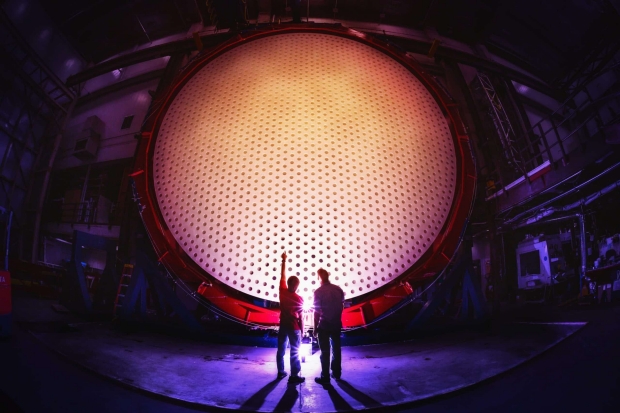
Image: University of Arizona Richard F. Caris Mirror Lab staff members Damon Jackson (left) and Conrad Vogel (right) in the foreground looking up at the back of primary mirror segment five, April 2019. Credit: Damien Jemison; Giant Magellan Telescope – GMTO Corporation. CC BY-NC-ND 4.0.
Imaging an exoplanet from the Earth’s surface is complicated by the Rayleigh Limit, which governs the resolution of our optical systems and their ability to separate two point sources. Stephen Fleming showed the equation in his talk on super-resolution imaging at the Interstellar Research Group’s recent meeting in Montreal. I use few equations on this site but I’ll show this one because it’s straightforward and short:
θ = 1.22 * (λ / D)
Here λ is the wavelength and D is the diameter of the mirror. What this says is that there is a minimum angular separation (θ) that allows two point sources to be clearly distinguishable, which in terms of astronomy means we can’t pull useful information out of the image when they are closer than this. I’ve pulled the image below out of Wikipedia (in the public domain, submitted by Spencer Bliven).
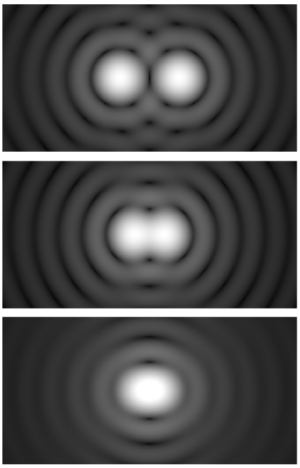
Image: Two Airy disks at various spacings: (top) twice the distance to the first minimum, (middle) exactly the distance to the first minimum (the Rayleigh criterion), and (bottom) half the distance. This image uses a nonlinear color scale (specifically, the fourth root) in order to better show the minima and maxima.
Here we have another useful term: An Airy disk is a diffraction pattern that is produced when light moves through the aperture of a telescope system. Light diffracts – it’s in the nature of the physics – and the Airy disk is the best focused spot of light that a perfect lens with a circular aperture can make. We’re looking at light interfering with itself, so in the image, we have a central bright spot with surrounding rings of light and dark. The diffraction pattern depends upon the wavelength being observed and the aperture itself. This diffraction can be described as a point spread function (PSF) for any optical system, and essentially governs how tightly that system can be focused.
Bigger apertures matter as we try to deal with these limitations, and the Giant Magellan Telescope will doubtless make many discoveries, as will all of the coming generation of Extremely Large Telescopes. But when we want to see ever smaller objects at astronomical distances, we run into a practical problem. Nothing in the physics prevents us from building a ground-based telescope that could see an Earth-class planet at Alpha Centauri, but if we want details, Fleming notes, we would need a mirror 1.8 kilometers in diameter to retrieve a 40 X 40 pixel image.
The point of Fleming’s talk, however, was that we can use quantum technologies to nudge into the Rayleigh limitations and extract information about amplitude and phase from the light we do collect. That, in turn, would allow us to distinguish between point sources that are closer than what the limit would imply. The operative term is super-resolution, a topic that is growing in importance in the literature of optics, though to this point not so much in the astronomical community. This may be about to change.
Counter-intuitively (at least insofar as my own intuitions run), a multi-aperture telescope does a better job with this than a large single-aperture. Instead of a 3-meter mirror you use three 1.7 meter mirrors that are spaced out over, perhaps, an acre. This hits at mirror economics as well, because the costs of these enormous mirrors goes up more than exponentially. The more you can break the monolithic mirror into an array of smaller mirrors, you can add to the data gain but also sharply reduce the expense.
In terms of the science, Fleming noted that the point spread function spreads out when multiple smaller mirrors are used, and objects become detectable that would not be with a monolithic single mirror instrument. The technique in play is called Binary Spatial Mode Demultiplexing. Here the idea is to extract quantum modes of light in the imaging system and process them separately. The central mode – aligned with the point spread function of the central star – is the on-axis light. The off-axis photons, sorted into a separate detector, are from what surrounds the star.
So in a way we’re nudging inside the Rayleigh Limit by processing the light, nulling out or dimming the star’s light while intensifying the signal of anything surrounding the star. I’m reminded, of course, of all the work that has gone into coronagraphs and starshades in the attempt to darken the star while revealing the planets around it. In fact, some of the earliest research that convinced me to write my Centauri Dreams book was the work of Webster Cash out at the University of Colorado on starshades for this purpose, with the goal of seeing continents and oceans on an exoplanet. I later learned as well of Sara Seager’s immense contributions to the concept.
Thus far the simulations that have been run at the University of Arizona by Fleming’s colleagues have shown far higher detection rates for an exoplanet around a star using multi-aperture telescopes. In fact, there is a 100x increase in sensitivity for multi-aperture methods. This early work indicates it should be possible to identify the presence of an exoplanet in a given system with this ground-based detection method.
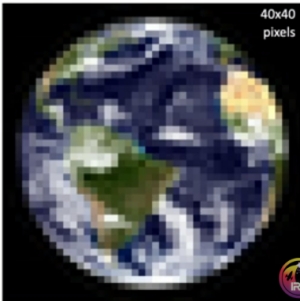
Can we go further? The prospect of direct imaging using off-axis photons is conceivable if futuristic. If we could create an image like this one, we would be able to study this hypothetical world over time, watching the change of seasons and mining data on the land masses and oceans as the world rotates. The possibility of doing this from Earth’s surface is startling. No wonder super-resolution is a growing field of study, and one now being addressed within the astronomical community as well as elsewhere.

